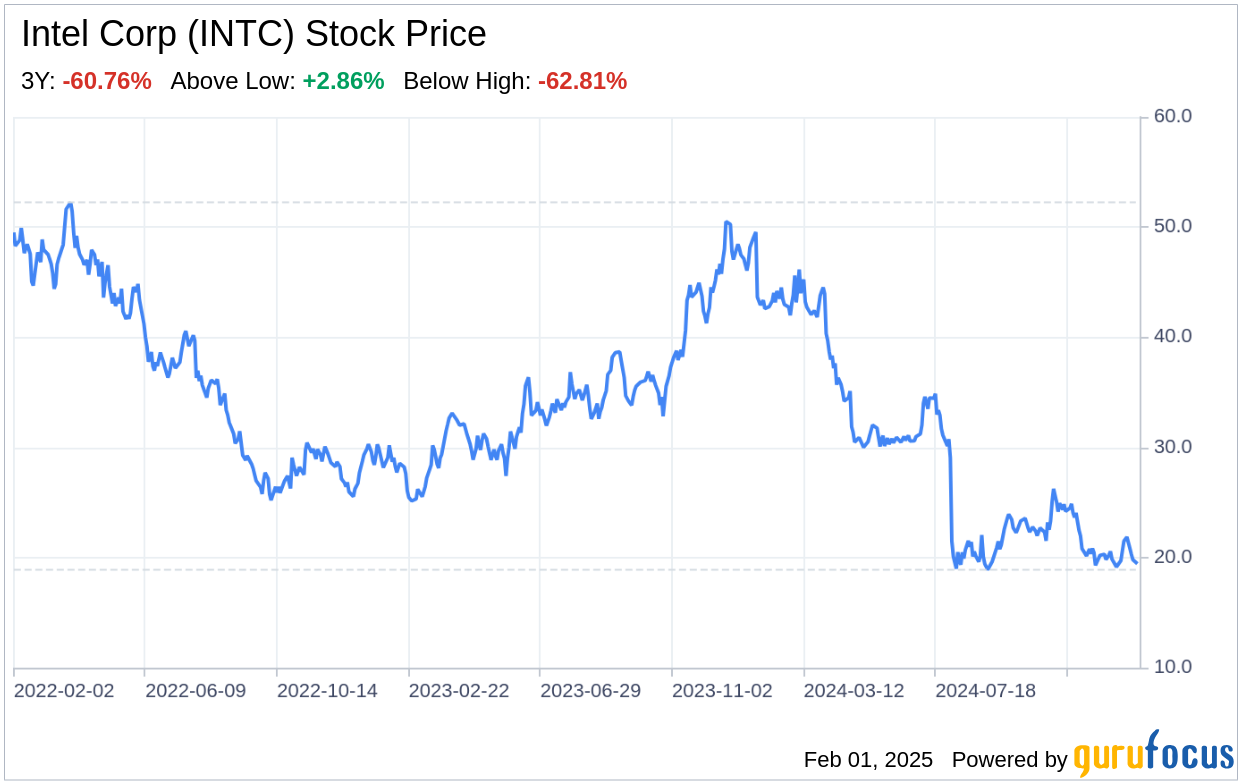Intel Corp (INTC, Financial), a global leader in semiconductor design and manufacturing, filed its 10-K on January 31, 2025, revealing a company at the forefront of technological innovation with a focus on microprocessors for the PC and data center markets. Intel's pioneering x86 architecture and adherence to Moore's law have cemented its position as a market share leader. The company's financials, as detailed in the filing, reflect a strong balance sheet and a commitment to leveraging its manufacturing capabilities into an outsourced foundry model. Despite suspending dividends and stock repurchases to prioritize critical investments, Intel's strategic initiatives, including the expansion into AI and the foundry business, signal a forward-looking approach aimed at long-term value creation.

Strengths
Brand and Market Leadership: Intel Corp's longstanding reputation as a technology innovator and its dominant market share in CPUs for PCs and servers are testaments to its brand strength. The company's ability to maintain leadership is supported by its extensive global factory network and continuous development of new manufacturing process technologies. Intel's commitment to Moore's Law has enabled it to offer innovative products that balance performance, power efficiency, cost, and size, meeting diverse customer needs. This technological prowess has allowed Intel to command premium pricing and customer loyalty, further solidifying its market position.
Advanced Manufacturing Capabilities: Intel's success is deeply rooted in its advanced manufacturing capabilities. With a significant majority of its core products manufactured using the Intel 7 process node and the ramp-up of Intel 4 and Intel 3 process nodes, Intel remains at the cutting edge of semiconductor manufacturing. The company's global factory network, which includes wafer manufacturing facilities in the United States, Ireland, and Israel, and assembly and testing facilities across the globe, provides Intel with product optimization, improved economics, and supply resilience. This vertically integrated model ensures control over the production process and quality, giving Intel a competitive edge in the market.
Weaknesses
Supply Chain Complexity: Intel's intricate global supply chain, while a strength, also poses significant challenges. The company has faced issues such as extended supplier lead times, capacity constraints, and disruptions from geopolitical tensions and public health crises. These complexities can lead to increased costs, production disruptions, and shipment delays, potentially damaging customer relationships and Intel's reputation. As the semiconductor industry continues to experience shortages and capacity limitations, Intel's ability to navigate these supply chain challenges remains a critical weakness that requires ongoing attention and strategic management.
Dependence on Continuous Innovation and R&D Investments: Intel's industry is characterized by rapid technological change and intense competition. The company's significant long-term investments in R&D and manufacturing facilities are inherently risky and may not always yield favorable returns. Intel's future success hinges on its ability to deliver competitive products consistently and to time its capital investments appropriately. Failure to do so could result in loss of market share and diminished investor confidence, making this dependence on continuous innovation and R&D a notable weakness.
Opportunities
Growth in AI and Emerging Technologies: The evolving market for products with AI capabilities presents a significant opportunity for Intel. The company's investments in AI, including the introduction of the Intel Core Ultra Series with integrated neural processing units, position Intel to capitalize on the increasing demand for AI-enabled devices. Furthermore, Intel's focus on heterogeneous computing architectures and advanced packaging technology aligns with industry trends towards more efficient and powerful computing solutions, opening up new markets and customer segments.
Government Incentives and Foundry Expansion: Intel stands to benefit from government incentives, such as the CHIPS Act funding, which supports domestic semiconductor manufacturing. The company's strategic pivot to expand as a third-party foundry for external customers, leveraging its leading-edge packaging and process technology, offers a new revenue stream and the potential to diversify its customer base. Intel's commitment to building capacity in the US and Europe provides a competitive advantage in a geopolitical climate increasingly focused on securing supply chains and reducing reliance on foreign manufacturers.
Threats
Geopolitical Tensions and Trade Conflicts: Intel operates in a global environment fraught with geopolitical tensions and trade conflicts, particularly between the US and China, and the ongoing war in Ukraine. These tensions can lead to supply chain disruptions, restricted access to markets, and increased regulatory scrutiny. Intel must navigate this complex landscape carefully to mitigate the potential negative impacts on its business operations and financial performance.
Intense Industry Competition and Technological Shifts: The semiconductor industry is highly competitive, with rapid technological advancements and shifting customer preferences. Intel faces competition from established players and emerging challengers that could erode its market share. The company's ability to compete effectively depends on its continued technological leadership and the successful execution of its product and process roadmaps. Any missteps in innovation or delays in product launches could provide an opening for competitors to gain an advantage.
In conclusion, Intel Corp (INTC, Financial) stands as a formidable player in the semiconductor industry, with a strong brand, advanced manufacturing capabilities, and strategic growth opportunities in AI and foundry services. However, the company must address weaknesses in its complex supply chain and dependence on continuous innovation to maintain its competitive edge. The threats posed by geopolitical tensions and intense industry competition underscore the need for Intel to remain agile and forward-thinking. By leveraging its strengths and opportunities while effectively managing its weaknesses and threats, Intel is poised to continue its legacy of technological leadership and market dominance.
This article, generated by GuruFocus, is designed to provide general insights and is not tailored financial advice. Our commentary is rooted in historical data and analyst projections, utilizing an impartial methodology, and is not intended to serve as specific investment guidance. It does not formulate a recommendation to purchase or divest any stock and does not consider individual investment objectives or financial circumstances. Our objective is to deliver long-term, fundamental data-driven analysis. Be aware that our analysis might not incorporate the most recent, price-sensitive company announcements or qualitative information. GuruFocus holds no position in the stocks mentioned herein.
